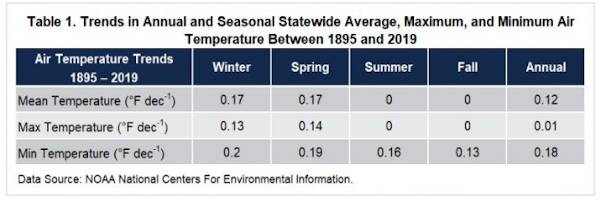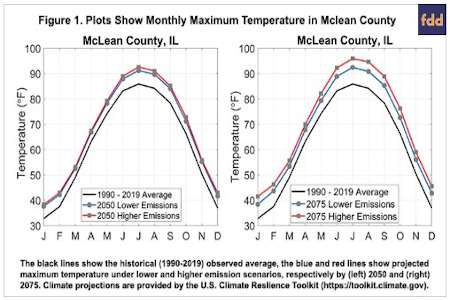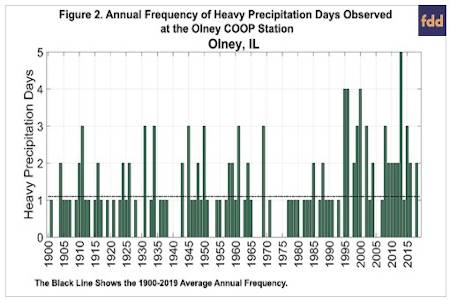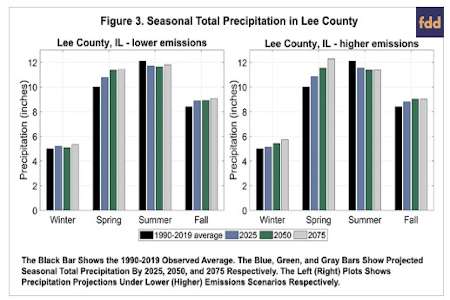By Trent Ford
Illinois State Climatologist
Illinois State Water Survey, Prairie Research Institute
University of Illinois
Global warming describes an observed increase in the global average temperature over the last 100 to 150 years. Illinois’ climate has changed over that time period in response to global warming. The last century of climate change in Illinois has had considerable implications to agriculture, and model projections suggest future changes will continue to impact Illinois agriculture. This article will briefly summarize the historical changes in Illinois’ climate observed over the last 100 years and model projections of continued climate change to the end of the century, and remark on the agricultural impacts of these changes in our climate.
Summary of Observed and Projected Temperature Changes
Air temperature has increased in Illinois over the last 100 years; however, unlike other regions in the United States, warming has been concentrated in meteorological winter (December – February) and spring (March – May) seasons. Table 1 shows trends in statewide annual and seasonal average, maximum, and minimum temperatures between 1895 and 2019 in units of degrees Fahrenheit per decade.

In all seasons daily minimum temperatures have increased at a larger rate than daily maximum temperatures, while maximum temperatures in meteorological summer (June – August) and fall (September – October) have exhibited no significant trend over 1895 to 2019 period. Increased humidity over the same time period contributes to larger changes in daily minimum temperatures than daily maximum temperatures, resulting in an overall decrease in daily temperature range and increased frequency of warm nights.
Model projections indicate a high likelihood of continued warming in Illinois throughout the 21st century. Figure 1 shows the projected change in daily maximum temperature for each month in McLean County by 2050 and 2075 under lower and higher greenhouse gas emission scenarios. The projections are provided by the U.S. Climate Resilience Toolkit (Gardiner et al. 2018; https://toolkit.climate.gov). Daily maximum temperatures are projected to increase irrespective of the magnitude of greenhouse gas emissions; however, the amount of warming is dependent on the emissions scenario with considerably larger increases under the higher emissions scenario. The projected differences in daily maximum temperature changes between emissions scenarios increase in the latter half of the century.

Temperature changes in Illinois over the last 100 years have impacted agriculture in multiple ways. The frost-free season has increased by approximately 9 days on average in Illinois, and is projected to increase by 10 to 20 days by 2050 depending on emissions. This has resulted in an overall longer growing season and increased accumulated growing degree days. For example, annual base 50°F corn growing degree days in DeKalb County are projected to increase 30% by 2050, relative to the 1990 – 2019 county average. In addition, increased growing season temperature and atmospheric carbon dioxide can enhance photosynthesis and reduce crop water use, both beneficial for growers.
However, temperature changes in Illinois have caused considerable negative impacts to agriculture as well, and these impacts are projected to increase in severity. For example, warmer winters have increased the survival and reproduction of insect pests, while fostering more suitable conditions for numerous invasive species of flora and fauna. Additionally, increasing spring and early summer temperatures result in earlier exceedance of maximum temperature thresholds for postemergence herbicide application. Projected continued warming in April, May, and June across the state will constrain spray hours and impact weed control.
Summary of Observed and Projected Precipitation Changes
Changes in precipitation and precipitation intensity over the last 100 years has arguably had the largest impact to Illinois agriculture. Statewide annual total precipitation increased 0.47 inches per decade between 1895 and 2019, but has increased by 1.33 inches per decade since 1990. Precipitation in Illinois has increased in all four seasons but trends are largest in spring and summer. For example, five of the top ten wettest springs on record in Rock Island, Aurora, and Mudelein have occurred after 2008. The calendar year 2019 was the 5th wettest on record statewide, and the wettest on record for 15 Illinois counties.
Increases in total monthly, seasonal, and annual precipitation has coincided with significant increases in the incidence of heavy precipitation. Figure 2 shows the annual number of heavy precipitation days in Olney, Illinois between 1900 and 2019. A heavy precipitation day is one in which the single day precipitation accumulation is in the top 1% of all days in which precipitation is observed. The horizontal black line shows the 1900 to 2019 average annual number of heavy precipitation days, which is slightly more than 1 per year. The Olney station observed fewer than 2 heavy precipitation days in only four of the last fifteen years, and in only seven of the last twenty five years.

Model projections indicate a high likelihood of continued increases in precipitation in Illinois throughout the 21st century. However, the projected precipitation changes vary seasonally, with the largest increases in spring. Figure 3 shows the projected change in seasonal total precipitation in Lee County by 2025, 2050, and 2075 under lower and higher greenhouse gas emissions scenarios. The projections are provided by the U.S. Climate Resilience Toolkit (Gardiner et al. 2018; https://toolkit.climate.gov). Precipitation is projected to increase, relative to the 1990 to 2019 average, in winter, spring, and fall and is projected to decrease in summer in both emissions scenarios. The magnitudes of spring precipitation increases and summer precipitation decreases are dependent on the emissions scenario, with higher emissions resulting in larger changes. In the higher emissions scenario, spring precipitation in Lee County is projected to increase by over 2 inches by 2075 while summer precipitation is projected to decrease by 0.70 inches by 2075, relative to the 1990-2019 average (Figure 3).

Precipitation changes in Illinois over the last 100 years have significantly impacted agriculture, primarily through excess moisture issues. Increased precipitation and precipitation intensity, particularly in spring, reduces flexibility for field preparation and can result in planting delays, as in 2019. Similar increases in early summer precipitation limits the number of spray days for herbicide application. Concurrently, more frequent heavy precipitation, as has been observed over the last 100 years in Illinois, increases soil erosion and nutrient runoff.
Projections indicate continued increases in winter and spring precipitation and precipitation intensity, signifying further excess spring moisture issues for Illinois agriculture. Given the projections, it is likely soil erosion and nutrient runoff issues will continue without adaptive practices for soil and water conservation. Precipitation projections are less sensitive to emissions scenarios than temperature; however, the absolute changes in spring precipitation are larger under the higher emissions scenario than lower emissions.
Conclusion
Illinois’ climate has changed over the last 100 years and it has had direct and varied impacts on agriculture. Increased temperatures have resulted in an expansion of the growing season; however, warmer winters have fostered a higher prevalence of insect pests and invasive species. Increased precipitation and the intensity of that precipitation continues to be a primary challenge for farmers, particularly in the spring planting window. Model projections indicate continued warming and increasing precipitation and precipitation intensity in Illinois throughout the 21st century. Some of these changes are projected to occur irrespective of present and near-future greenhouse gas emissions, signifying the importance of agricultural adaptation efforts to reduce vulnerability to the impacts of climate change. The magnitude of these changes and the realized impacts remain very dependent on future greenhouse gas emissions. Therefore, mitigation efforts now and into the future could help limit climate change, as well as the risks it poses to Illinois agriculture, creating an overall more resilient agriculture system. The excess water issues faced by farmers last year and this season provide a very timely example of the challenges climate change poses to Midwest agriculture. Further analysis on the within season impacts on precipitation is a critical area for better understanding the risks to agriculture and will be explored further in future articles.
Source : illinois.edu